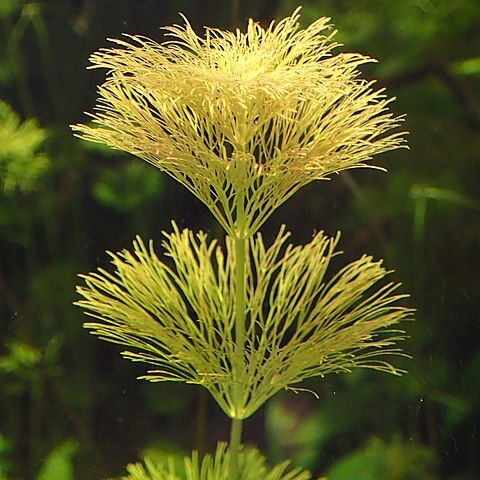A herb which keeps growing from year to year. It grows in water. The stems can be branched. They are slender and 15-30 (-90) cm long. They can be erect or lie over. The top rises out of the water. These aerial stems have glands while the under water stems are smooth. The leaves above the water are arranged in whorls or rings and are only partly divided. They are 4-12 cm long. The leaves smell of turpentine when crushed. The under water leaves can be 30 cm long and in whorls or rings of 6-12. They are often finely divided. The flowers are produced singly in the axils of leaves. The have stalks 3.5-10 mm long. The flower is pink or purple. The tube is slender and like a cylinder. The fruit is an oval capsule 4 mm long. It splits into 4 vales. There are many seeds inside. They are 0.5 mm long.
Leaves on aerial stem usually all verticillate and variously dissected, (2.5)4–12(22) mm. long, sometimes 2–3 pairs of opposite, undissected, crenate-serrate to lacerate, 1–3 nerved leaves towards apex, up to 15 x 4 mm., sessile-glandular to sub-glandular, rarely all aerial leaves undissected; submerged leaves up to 30 mm. long, verticillate in whorls of 6–12, pinnatisect with lobes flattened or capillary.
Bracteoles 2, (1.5)3–4 mm. long, linear to linear-oblong to obovate-lanceolate, acute, entire to irregularly remotely serrate-dentate to occasionally deeply incised, glandular to subglabrous.
Stems: aerial part 2.5–14 cm. tall, simple to much branched, slender, with sessile or stipitate glands above becoming sub-glabrous; submerged stem up to 1 m. long, much branched, glabrous.
Calyx 3.5–6 mm. long, sessile glandular, rarely sparsely hirsute, not striate at maturity; lobes 2–3 mm. long, broadly ovate to lanceolate, shortly acuminate, occasionally ciliate.
Aquatic. Finely divided, submerged leaves present. Flowers sessile 6-12 mm long. Upper aerial leaves on flowering stems entire or shallowly toothed. Flowers white to pale yellow.
Pedicels (1)3.5–10(15) mm. long, sessile glandular to stipitate glandular, usually, though not always, longer than subtending leaves.
Corolla (6)8–12 mm. long, white to pale yellow, or yellow at base of tube, mauve-pink above, glabrous without; lobes all entire.
Slender glabrous or slightly glandular-pubescent herb, branched or simple, a few inches to 2 ft. long
Stamens with anthers contiguous; posterior filaments 2 mm. long, anterior 4 mm. long, all glabrous.
Style up to 4.5 mm. long with two lateral processes about 0.2 mm. wide at apex and below stigma.
Capsule about 3.5 mm. long, compressed ellipsoid to sub-globose, dark brown.
Flowers solitary, axillary, slender pedicellate.
Amphibious perennial herb.
Flowers small, white


